The Enigma of the Double: Sources and Symbols in Alberto Savinio’s Poetics
Nicol Maria Mocchi Nicol Maria Mocchi Alberto Savinio, Issue 2, July 2019https://italianmodernart-new.kudos.nyc/journal/issues/alberto-savinio/
This paper analyzes one of the most ambiguous and enigmatic themes within the poetics of Alberto Savinio: that of the double, which continually resurfaces in the author’s work, taking on different meanings – from the concept of hermaphroditism to that of half-death, and from those of the mask to the shadow. Through a brief historical-theoretical excursus, the presentation will retrace chronologically the evolution of this fascinating topic in the vast musical, pictorial, literary and theatrical production of the minor of the “Dioscuri.”
This essay discusses a favorite theme of Alberto Savinio: the double. Taking on different meanings and aspects, this theme continually resurfaces in his work, from the general concept of the metaphysical Weltanschauung’s dual reality, to the particular ideas of double personalities contained in the concepts of the shadow, half-death, the mask, and hermaphroditism – the leitmotifs of Savinio’s “creative power station,” as he defined it.1
The etymology of the word double originates in the Latin duplus, defined as one made up of two parts, not necessarily identical but different, and the theme of the double refers to the ontological dualism – the existence of two antithetical principles, often struggling with each other – that can be conceived in any field, whether philosophical, religious, political, or scientific. This understanding of a double vision of the world is ancient in origin and extends throughout the history of modern thought. It takes its meaning from the light/dark dualism of ancient Zoroastrian religion and of pre-Socratic philosophy, followed, centuries later, by René Descartes’s contraposition of res cogitans and res extensa, the metaphysical duplicity of phenomenon and noumenon in Immanuel Kant, variously taken up by Arthur Schopenhauer and Friedrich Nietzsche, and declined in the binomial ego and superego in Sigmund Freud and structure and superstructure in Karl Marx. These are just some examples of how the double Weltanschauung had a rich tradition before breaking, like a wave, in the metaphysical poetics that the de Chirico brothers developed between 1909 and 1911, aimed at discovering and expressing the hidden spirit of things, the symbolic or double dimension of reality.
In “‘Anadioménon.’ Principi di valutazione dell’arte contemporanea” (‘Anadyoménon.’ Assessment principles of contemporary art), which is the cornerstone of Savinio’s aesthetics, published in May 1919 in the Roman journal Valori plastici, he conceived of the metaphysical as “everything real that continues to be beyond the roughly self-evident aspects of reality itself.” The aim of art was to reproduce “the spectrality [that] is the true, spiritual, and substantial essence of every aspect,” namely the internal appearance of things, “cleansed of every overlapping of heterogeneous elements.”2 In Savinio’s early tale La casa ispirata (The inspired house, 1925; initially published in installments in 1920), the essential quality of the artist-poet is mentioned as the “double sight” or “double look,”3 concepts borrowed from the “second sight” of Schopenhauer to indicate a borderline state between dream and hallucination, clairvoyance and magic, where the true essence of reality can be grasped. Around the same time, Giorgio de Chirico, alluding to the revelations from which the first metaphysical masterpieces were born, stated that everything has two aspects: “a current one, that we see almost always and what people generally see, and another spectral or metaphysical one, which only rare individuals can see in moments of clairvoyance and metaphysical abstraction.”4
The theme of the double, in the metaphysics of the two brothers, is not simply present as a metamorphic dualism of reality; rather, it penetrates the inner dimension of modern man as a doubling of the ego. This “psychological” double – in flesh-and-blood form (think about the Roman playwright Plautus’s comedy of misunderstandings) and also as shadow, soul, reflection, or portrait detached from the self – came back as a trend in the nineteenth and twentieth centuries, most especially in the fantastical narratives of Ernst Theodor Amadeus Hoffmann, Adelbert von Chamisso, and Alfred de Musset, as well as Fyodor M. Dostoevsky, Guy de Maupassant, Franz Kafka, Edgar Allan Poe, Robert Louis Stevenson, and Oscar Wilde. All of these authors recount the phenomenon of the Doppelgänger, literally “a double walker” or “double goer,” who personifies the dark and unknown side that dwells within the self.
The de Chirico brothers, too, obviously underwent its charm, as the majority of their metaphysical works document, but they confer a much broader and complex range of interpretations than just Symbolism and Decadentism – by giving a value not necessarily negative, but rather full of constructive and emancipating possibilities. The double, for both, was not an invisible, oppressive enemy to be resolutely fought against. It was not even a desperate escape from bourgeois boredom, or a manifestation of schizophrenic dissociation tout court. Quite the opposite: it assumed, with the usual metaphysical lightness and irony, the connotations of an enigmatic, outrageous, and magical force, on the one hand a form of liberation, and on the other a deep level of knowledge.
The de Chirico brothers considered the soul, in a strictly secular sense, the double of the man, his Kâ. Giorgio, in a 1919 article in Ars Nova, wrote of “the possibility of the existence of immaterial forms, of imagining one of our doubles, one of our Khâ, to speak as an Indian, made up of fluids and incorporeal substances.”5 Savinio remembered that in Lucian’s dialogues the shadows, from the afterlife, accuse the man of mistakes made during his lifetime: “the shadow as a double (Kâ), the shadow as a soul that can also be sold to the devil (Peter Schlemihl), the shadow that must not be placed next to the body that one wants to preserve in a condition of immortality (Giotto’s figures who have no shadow).”6 This shadow inspired fear, being the “darkness” of ourselves.
Often, the theme of the double was reexperienced by Giorgio and Alberto in an autobiographical and mythical key, that is, as the duality of two brothers who identified with the Dioscuri, Castor and Pollux, who departed with the Argonauts from the small port of Volos in Thessaly (where Giorgio was born, in fact) in search of the Golden Fleece (figure 1).
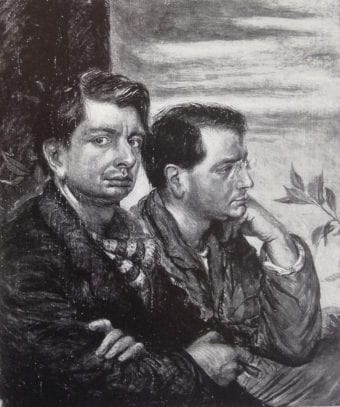
They identified also with the mythical figure of the hermaphrodite, repeatedly represented and evoked in their respective works. Savinio gave the title Hermaphrodito to his first book, published in 1918.7 For him, the hermaphrodite coincided with an innocent, childlike state, an emblem of a newfound harmony between opposites, prior to the decision by Jupiter – envious of the double men – to “cut them in the middle like pears,” resulting in “two of each.”8 This seems almost a metaphor of the “twin spirit” shared by the two brothers in their earliest years. Savinio remembered this period as when “nothing divided us yet and we had only one thought in two,”9 before their paths separated. Especially in their Italian period, the brothers painted quite probably similar subjects – for example, Giorgio’s L’enigma dell’oracolo (The enigma of the oracle, 1909), and Alberto’s Oracolo (Oracle, c. 1909; figures 2–3), the only juvenile drawing so far known of him – and they collaborated on a first music concert by Savinio, planned for the Teatro della Pergola in Florence, but held instead in Munich in January 1911.
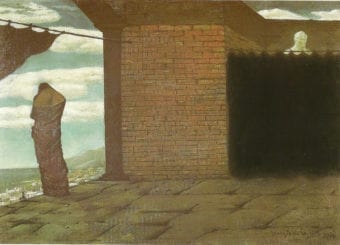
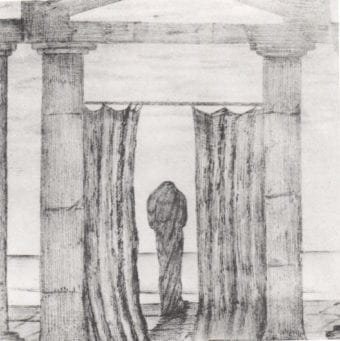
Some parts of the section “Le Rivelazioni. La musica più profonda sinora scritta” (The revelations: The most profound music ever written) were composed by Giorgio, others by Alberto (figure 4).
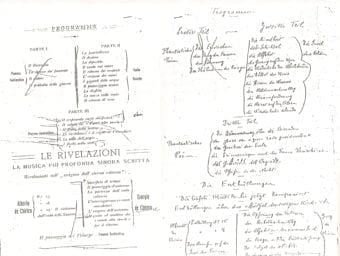
Despite the almost symbiotic complicity of sensations and deductions that characterize the de Chiricos’ early works, there are considerable poetic diversities precisely in relation to the theme of the double, considering the different means of expression adopted by the two brothers. For Giorgio, who was mainly a painter and a poet with a more romantic view, the double expressed mostly an intimate, narcissistic self-contemplation, always lived in an ironic key, or it revealed his animistic opposite, as shown by the many double self-portraits of the twenties, for example Autoritratto con ombra (Self-portrait with shadow, 1920; figure 5), in which the outline of the white shadow is undeniably that of the painter; whereas for the encyclopedic Alberto – a musician, writer, essayist, critic, painter, set designer, and illustrator incessantly in search of the most congenial expressive form to suit his purposes – the double could take several aspects not immediately graspable.
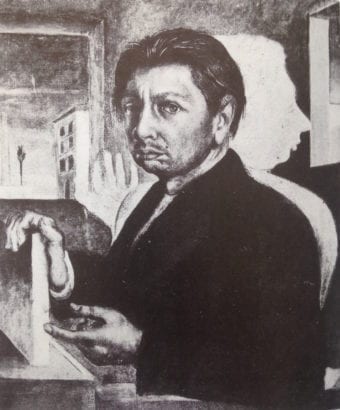
At times it was a ghost or life force capable of passing from one state to another while preserving the memories and feelings of earthly life; at others it was a conscience, at once angelic and diabolical, expressive of the darkest, scariest sides within us. In this regard, there is a disquieting illustration by Savinio of Lucian’s dialogues, Le ombre sono gli accusatori (The shadows are the accusers, 1944), clearly taken from the artist Max Klinger, who was an important inspiration to the brothers. In Klinger’s etching Schande (Shame, 1887), for example, only the woman marked by shame casts the blackness of herself onto the wall (figures 6–7).
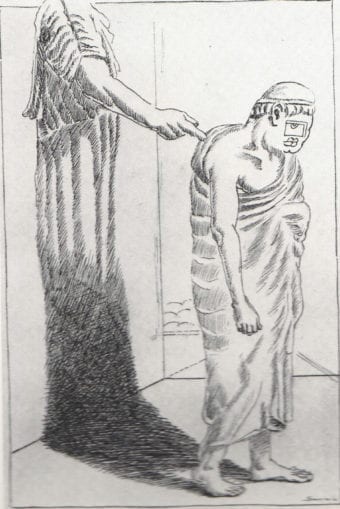
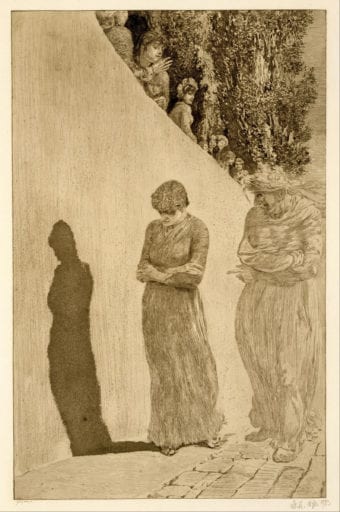
In Savinio’s stories, music, and paintings, there are characters that closely resemble the protagonist – in physiognomy, in bearing, and even in name. Each appears “almost stolen from a mirror,” according to Hoffmann’s definition.10 They are so many alter egos in Savinio’s works that apparently he lived through the possibility of an other existence, or through the appropriation of another identity. Such “superior beings” are reminiscent of the Nietzschean superman, “beyond good and evil” and transcending all “human, too human” limits. It is important to underline that Savinio, like his brother, was very superstitious. “If a breath touched our face or our hand,” he wrote, in recollection of the period he defined as “spectral” (fantasmico), “we used to say: A ghost has passed by.”11 Despite the plurality, sometimes utterly ineffable, of meanings that Savinio gave to the double, there is an identifiable constant: the thought of death runs through almost his entire body of work, populated, as it is, by “returners,” ghosts, the reincarnated, and assorted paranormal phenomena.12 Both brothers shared this thought following the death of their father in 1905. An aphorism about death is offered in an early essay by Alberto de Chirico (as he was then called), published in the modernist journal Cœnobium (figure 8),13 dated October 5, 1909, and written in Milan (Savinio had come there from Munich in hopes of publishing his musical work Carmela).
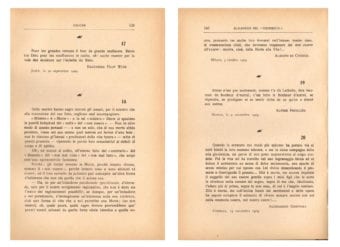
Written in sophisticated and emphatic language, it paradoxically defines death as a “passing from nonbeing to being: to die, that is, from Death to Life!”14 and vice-versa.
This circular and double conception of existence is ancient, linked to the primal fear of death and to the chance of survival in the afterlife – as in the Greek Eidolon, the Egyptian Kâ, the Roman Genius, the Christian Guardian Angel, the Hebrew Rephaim.15 It derives on the one hand from the theory of the “eternal return,” but also from that of death as an act of “will of power,” as developed by Nietzsche, or from Giacomo Leopardi’s nihilism, as clearly expressed in his metaphorical “Cantico del gallo silvestre” (Song of the great wild rooster, 1827), where the sleep of humans is equated with life.16 The de Chirico brothers were intensely studying Nietzsche and Leopardi in the Italian period, as their initial “metaphysical” works demonstrate – beyond the de Chiricos’ paintings, there were the “revelations” of the first musical concert, works that reflect a broad background of knowledge. The brothers’ readings on the history of myth; the birth of language, and of religion; and more generally, the origins of Western thought are documented in the registers of the National Libraries in Milan and Florence, where they were living from the summer of 1909 to the spring of 1911 (Savinio had moved to Paris a few months before).17
In particular, the books of Ernest Renan18 and Gaston Maspero19 on ancient Indo-European, Eastern, and Semitic civilizations disclosed to Savinio new, fascinating perspectives on the theme of the double, as evidenced by his handwritten notes preserved at the Gabinetto Vieusseux archives in Florence. The double was described by these authors as a vital force with marked personal traits, and as a kind of animated shadow that grew up with a man without ever abandoning him, able to preserve the memories, the feelings, and the basic needs of earthly life. A man had to care for his double as if it were his own physical reality. “One had to feed him, dress him, distract him,” wrote Maspero, considering it as a sort of “magnetic fluid.”20 In an article from the forties dedicated to the “Potenza del verbo” (Power of words), Savinio provided an almost similar interpretation of Maspero’s theories on the magic value of the double: “For the Egyptians, the name was an integral part of the Kâ of the individual and constituted in a certain way the psychic synthesis of him, reabsorbed all his magnetic force.” More significantly, he continues: “To keep this very precious part of himself safe from dangers, to forbid that enemies could use it to attack the Kâ and destroy it, the Egyptian hid his name under a nickname.”21 Closely connected to the mysterious power of the double, which Savinio had learned from ancient religions and Egyptian folktales, is in fact the concept of the pseudonym, which assumes an essential role in his poetics. Savinio attributed to names, and therefore also to nicknames, a fateful, almost divinatory symbolic value, able to influence the destiny of people and determine their “greatness.”22
Throughout his literary works, Savinio loved to hide behind innumerable alter egos, such as Aniceto, Nivasio Dolcemare, Mister Dido, Mister Münster, Innocenzo Paleari, Animo, Carmelo, etcetera. And his actual name must not be forgotten! Alberto de Chirico decided to appropriate the nom de plume Savinio in order not to passively endure his destiny, to instead put it under the best auspices, as well as to distinguish himself from his brother Giorgio. He was most likely encouraged by his friend Guillaume Apollinaire, who, for his part, had been born Wilhelm Apollinaris de Kostrowitzky. Savinio first applied his pseudonym upon the publication, in Apollinaire’s magazine Les soirées de Paris, of “Le drame et la musique” (The drama and the music, 1914), theoretical prelude for “Les chants de la mi-mort” (Songs of the half-dead, 1914), a series of “dramatic episodes” set in the Risorgimento (he also wrote music and designed sets and costumes for the piece).
Based on studying Savinio’s readings from his Italian period, it can be hypothesized that Savinio’s pseudonym derived not so much from the French publisher and writer Albert Savine, who was a rather irrelevant figure on the cultural level, but from the visionary swordsman-poet Savinien Hercule Cyrano de Bergerac,23 a baroque writer and “amateur” (dilettante) in its positive sense, and the protagonist of an Edmond Rostand theatrical piece that Savinio borrowed from the library in December 1909. On Cyrano’s grave is written: “Philosopher, scientist, poet, swordsman, musician, aerial traveler, maker of sharp retorts, and lover (not to his advantage!) […] who was everything, and who was nothing.” The reference in his name to Herculean mythology makes a fairly obvious connection to the “muscular idealists”; among such figures it was Hercules, according to Savinio, who began to purge the earth of monsters before passing the task to artists and writers. In one of his Parisian paintings, Senza titolo – Couple et enfant (Untitled – couple and infant, 1927; figure 9), Savinio metaphorically portrayed himself as a young Hercules who has just strangled snakes (for the iconography, he used a repertoire of classical images by Salomon Reinach) alongside the frozen and disoriented figures of his mother, Gemma, and father, Evaristo.
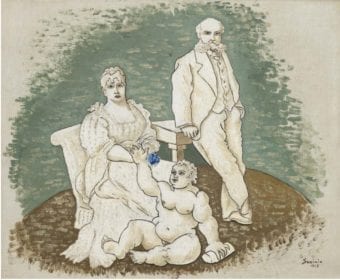
Even the concept of half-death is nothing but a manifestation of the duplicity of the human condition and of the relativity of existence, for Savinio understood half-death as the state of clairvoyance that some individuals experience in that limbo of perception that lies between wakefulness and sleep, when the hidden language of things can be captured and their spectral interiority unveiled. Thus understood, half-death relates once again to the Nietzschean idea of time as an “eternal return” and an “eternal present”; it indicates a time suspended between a past – all that no longer exists – and a future – all that has yet to be. Thus death may be metaphorically conceived as a door that can be opened in both directions, making possible a “return” in the form of a “revenant,” or ghost, one of the central figures of the metaphysical art.
The “revenant,” which will reappear transfigured in many works by Savinio, has one of its first formulations in the manuscript of the ballet entitled Deux amours dans la nuit (Two lovers in the night), created in Paris in 1913 in collaboration with the Greek composer Michael Calvocoressi. The main narrative’s characters are: an old man, or rather his “double,” who, acting as if half asleep, kills two lovers; the portrait of a young woman who “comes alive and pops out from the shadows;” and a half-dead bunch that will “climb on the bed” or chase the old man “like robots.”24
But it is in the concept of the shadow, also mentioned in this “surrealistic” theatrical piece, that the theme of duality finds perhaps its most original expression, opening onto new meanings. This begins with Savinio’s superstitious and animistic conception, typical of the nineteen-tens and twenties, and similar to that of his brother Giorgio, expressed in the various conceptual and emotional contrasts: light/shadow, life/death, good/evil, body/soul, living person/sculpture, being/not being. It developed into increasingly complex interpretations in the thirties and forties, which enhanced that ambiguity, that cosmic tension of thought, that was for Savinio “sweet and comfortable;” these interpretations were also prompted by new discoveries in science, as Savinio stated programmatically in 1947: “I try to see the world through the teachings of the new physics that no longer admit mobile-immobile (or body-soul) duality, but only the same continuous movement of energy.”25 During the Second World War, in perhaps the most prolific period of his copious literary and journalistic production, the theme of the shadow unfolded metaphorically, for instance in the story “Il compagno di viaggio” (The traveling companion, 1942), in the Pirandellian revelation of a disquieting cohabitation with his own shadow,26 or in the narcissistic projection of himself in the story of Caterino, published in 1938, of whom Savinio wrote that “for a form of metaphysical narcissism […] Caterino gradually isolated himself, detached himself from other men, from things, and finally, raised himself to the supreme state of isolation, he then killed Caterino.”27
And again, the theme of the shadow resulted in the exaltation of “that obscure, that evil, that assertive creature that lived inside him,” as elaborated in Savinio’s Maupassant e “l’altro” (Maupassant and “the other,” 1942), that dark “tenant” that, after having “dictated” all his stories to Maupassant, made him lose his senses.28 But in Savinio’s kaleidoscopic vision, the same figure can turn out to be wise, protective, and divine. “And if the shadow was the best of us, the wisest, the most ‘enlightened’?” wonders Savinio.29 In the story “Anima” (Soul, 1942), Nivulo – yet another alter ego of the author – keeps in his body the soul of his older brother, so wise that “he did not have to learn anything from anyone.”30
The topos of the shadow, to which Savinio devotes two voices of his Nuova enciclopedia (New encyclopedia, 1977), also emerged in his pictorial production, but with results often opposed to his brother. In the first metaphysical masterpieces of de Chirico, for example, L’énigme d’un après-midi d’automne (The enigma of an autumn afternoon, 1909; figure 10), the shadow plays the chief task of evoking Nietzschean themes of time, suspended between the shadow of the past and the light of the future; it then evolved into increasingly looming, threatening plastic presences projected by unknown sources and hidden bodies, as in Mystère et mélancolie d’une rue (Mystery and melancholy of a street, 1914; figure 11).31
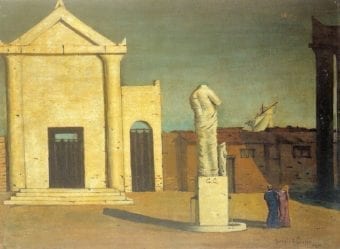
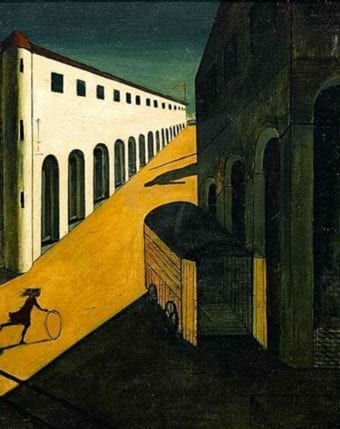
In Savinio’s paintings it is comparatively difficult to find shadows as plastic and tightly geometrical, or shadows used for expressive and psychological purposes. Paradoxically, all that is represented, even if there is an intense light source – as in the painting Les rois mages (The wise man, 1929; figure 12), which features a platform full of colorful objects, including the Star of David, flying over the desert – does not cast or carry shadows to enhance the illusionistic perspective or for symbolic purposes.
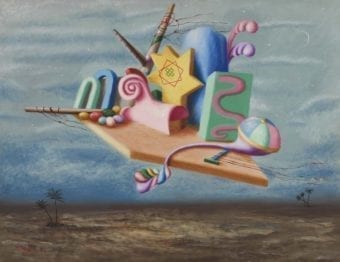
“But is there a difference, basically, from one shadow to another?” asked Savinio, seriously, in a post-World War II piece of writing.32 The objects, but also the figures, in his paintings appear rather “stripped” of their shadows – for example in the Baconian Atlante (Atlas, 1927; figure 13) or in Senza titolo – Couple et enfant – with the effect of photographic overexposure or collage defeating, as intended by Savinio, “the cloud of chiaroscuro,” thus “to clean them of the rhetoric, theatricality, vulgarity of the carried shadow.”
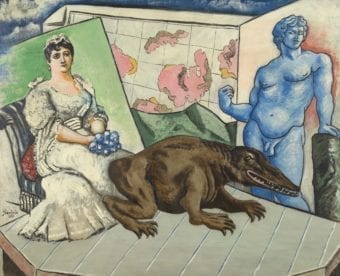
So did his friend the painter “R.” – no better identified – and so did Giotto, who, in order that the “immortality conditions” of things and figures might be preserved, did not paint the shadows of bodies.
The superstitious Savinio limited himself to discretely suggesting the double through the presence of various poetic surrogates, such as the “wind/soul”33 that shakes curtains or makes the most unexpected of objects vibrate, or more incisively, in the impersonation of numerous alter egos. In his paintings of the late twenties, Savinio experimented with the doubling of naked bodies (Les Dioscures [The Dioscuri, 1929], Le Retour [The return, 1929]; figures 14–15), and also their melting together (Oreste e Pilade [Orestes and Pylades, 1930], Les ennemies de l’Olympe [The enemies of Olympus, 1929]; figure 16).
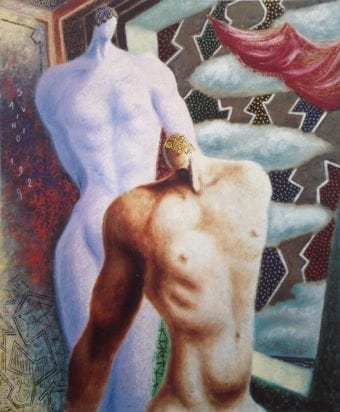
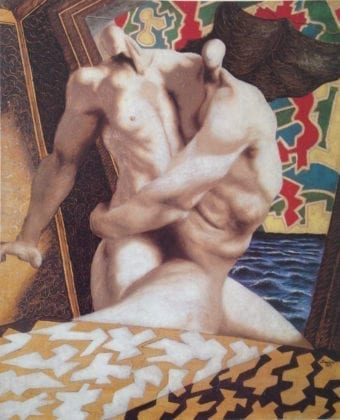
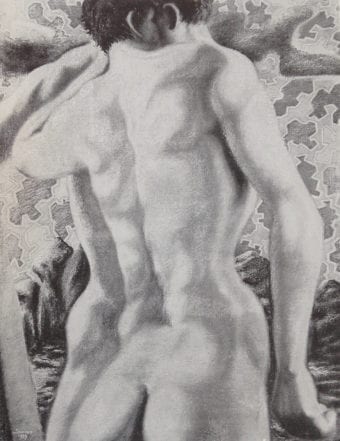
In his later images, and especially in the portraits of the late thirties and forties, in proximity to the Second World War, the double conveys an increasingly declared intellectual discomfort. It oscillates between, on the one hand, the incommunicability of different personality traits and the loss of an individual’s identity and vanity, and, on the other, the impermanence of the whole, as can be seen in contemporaneous writings by Savinio. Particularly relevant here is the penetrating Autoritratto in forma di gufo (Self-portrait as an owl, 1936; figure 17), which picture reveals Savinio’s obscure role as the nocturnal bird par excellence in an eighteenth-century habit.
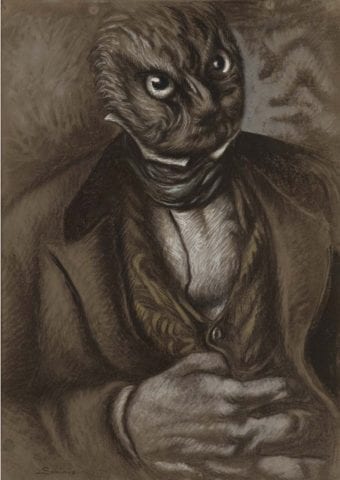
In other late canvases, duplicity embodies precise evocations of death, as in L’anatomico (The anatomical, 1951; figure 18), a portrait of Elvio Cecchi, the artist’s doctor, which elaborates on Böcklinian suggestions from his famous self-portrait with death; or duplicity looks like a good-natured and luminous ghost, as in Doppio ritratto di Sante Astaldi (Double-portrait of Sante Astaldi, 1950; figure 19), especially when compared to the mysterious “double” portrait of his friend the professor Roger Lacombe, from twenty years before (figure 20).
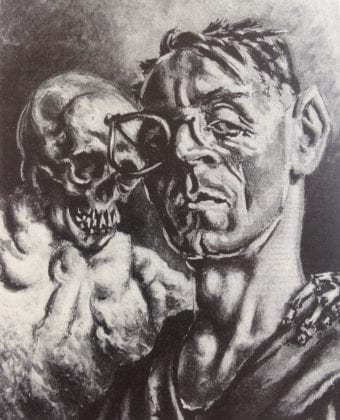
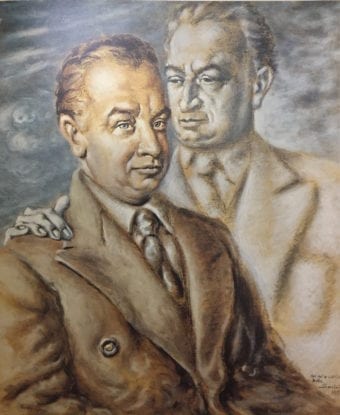
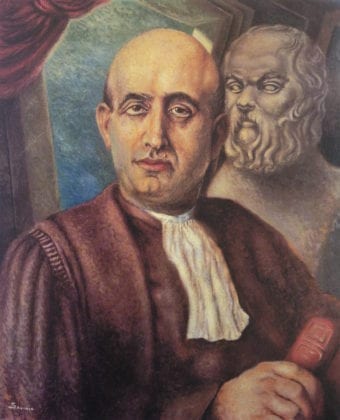
But, as the great Savinian scholar Pia Vivarelli has written precisely about the aforementioned Sante Astaldi portrait, “the integrity of this shadow prevails over the ambiguity of the doubling of the self, not altered by the usual interventions of metamorphosis, and the calmness of this protective demon.”34
Bibliography
Baldacci, Paolo. “All’ombra dell’ultimo sole, l’ombra dal tardo romanticismo a De Chirico.” Art e dossier 264 (March 2010): 46–51.
Baldacci, Paolo. De Chirico, 1888–1919. La metafisica. Milan: Leonardo Arte, 1997.
Biserni, Marcella. “La maschera e l’ironia dell’Altro nelle metamorfosi di Savinio.” In La maschera e l’altro, edited by Maria Grazia Profeti, 421–38. Florence: Alinea, 2005. Conference proceedings.
De Chirico [Savinio], Alberto. “no. 18.” In Almanacco del ‘Cœnobium’ pel 1910, illustrato con 12 disegni originali giapponesi a colori, 139–40. Lugano: Casa Editrice del Cœnobium, 1910.
De Chirico, Giorgio. “Arte metafisica e scienze occulte, seguito da un epòdo.” Ars Nova 3, no. 3 (January 1919). Reprinted in De Chirico, Il meccanismo del pensiero: critica, polemica, autobiografia, 1911–1943, edited by Maurizio Fagiolo dell’Arco, 62–65. Turin: Einaudi, 1985.
De Chirico, Giorgio. “Sull’arte metafisica.” Valori plastici 1, nos. 4–5 (April–May 1919). Reprinted in De Chirico, Il meccanismo del pensiero: critica, polemica, autobiografia, 1911–1943, edited by Maurizio Fagiolo dell’Arco, 83–88. Turin: Einaudi, 1985.
Delcourt, Marie. Hermaphroditea. Recherches sur l’être double promoteur de la fertilité dans le monde classique. Brussels: Latomus, 1966.
Giacomazzi, Giuseppina. “Il doppio in Alberto Savinio.” In Identità e diversità nella lingua e nella letteratura italiana, III: Poesia e narrativa del Novecento, Atti del XVIII congresso dell’AISLLI, edited by Michel Bastiaensen, 233–44. Florence: Cesati, 2007. Conference proceedings.
Hoffmann, E. T. A. Fantasiestücke in Callot’s Manier. Bamberg: Kunz Verlag, 1819.
Italia, Paola. Il pellegrino appassionato. Savinio scrittore 1915–1925. Palermo: Sellerio editore, 2004.
Italia, Paola. “‘Leggevamo e studiavamo molto.’ Alberto e Giorgio de Chirico alla Braidense (1907–1910).” In Origine e sviluppi dell’arte metafisica. Milano e Firenze 1909–1911 e 1919–1922, edited by Paolo Baldacci, 11–23. Milan: Scalpendi, 2010. Conference Proceedings.
Laghezza, Beatrice. “Metafisica e Allegoria nei doppi di Alberto Savinio.” Studi novecenteschi 38, no. 81 (January—June 2011): 29–69.
Landini, Carlo Alessandro. Lo sguardo assente. Arte e autismo: il caso Savinio. Milan: Angeli, 2009.
Maspero, Gaston Camille Charles. Histoire ancienne des peuples de l’Orient, Ouvrage contenant trois cartes et quelques spécimens des écritures hiéroglyphiques et cunéiformes, 4ème édition entièrement refondue. Paris: Librairie Hachette et Cie, 1886.
Maspero, Gaston Camille Charles. Les Contes populaires de l’Égypte ancienne, 3ème édition entièrement remaniée et augmentée. Paris: Guilmoto Éditeur, 1905.
Mocchi, Nicol M. “Alberto Savinio. Enigmatica origine di uno pseudonimo: una nuova ipotesi.” Studi OnLine 1, no. 1 (January–June 2014): 9–16.
Mocchi, Nicol M. “Alberto de Chirico e la rivista ‘Cœnobium’ (1909–1910): il primo testo edito di Savinio.” Studi OnLine 1, no. 2 (July–December 2014): 1–12.
Mocchi, Nicol M. La cultura dei fratelli de Chirico agli albori dell’arte metafisica, Milano e Firenze 1909–1911, con uno scritto di Paolo Baldacci. Milan: Archivio dell’Arte Metafisica / Scalpendi, 2017.
Morin, Edgar. L’homme et la mort dans l’histoire. Paris: Corrêa, 1951.
Porzio, Michele. “Deux Amours dans la nuit: Savinio et la naissance du théâtre métaphysique.” Revue d’esthétique. Esthétiques en chantier 24 (1993): 93–100.
Rank, Otto. Der Doppelgänger. Eine psychoanalytische Studie. Vienna: Internationaler Psychoanalytischer Verlag, 1914.
Renan, Ernest. Histoire du peuple d’Israël. 5 vols. Paris: Calmann-Lévy, 1887–93.
Roos, Gerd. Giorgio de Chirico e Alberto Savinio: ricordi e documenti, Monaco, Milano, Firenze 1906–1911. Bologna: Bora, 1999.
Savinio, Alberto. Alcesti di Samuele. Milan: Bompiani, 1949. Reprinted in Savinio, Alcesti di Samuele e atti unici, edited by Alessandro Tinterri, Milan: Adelphi, 1991.
Savinio, Alberto. “‘Anadioménon.’ Principi di valutazione dell’arte contemporanea.” Valori plastici 1, nos. 4–5 (May 1919). Reprinted in Savinio, La nascita di Venere: scritti sull’arte; con nove disegni dell’autore, edited by Giuseppe Montesano and Vincenzo Trione, 45–63. Milan: Adelphi, 2007.
Savinio, Alberto. “Anima.” La Stampa (September 1942). Reprinted in Savinio. Tutta la vita, edited by Paola Italia, 101–11. Milan: Adelphi, 2011.
Savinio, Alberto. Ascolto il tuo cuore, città. Milan: Bompiani, 1944.
Savinio, Alberto. “Attila.” From the novel La famiglia Mastinu (1948). Reprinted in Savinio, Casa “la vita” e altri racconti, edited by Alessandro Tinterri and Paola Italia, 758–69. Milan: Adelphi, 1999.
Savinio, Alberto. Casa “la vita.” Milan: Bompiani, 1943.
Savinio, Alberto. Hermaphrodito. Florence: Libreria della Voce, 1918.
Savinio, Alberto. “Il compagno di viaggio.” La Stampa (August 1942). Reprinted in Savinio, Tutta la vita, edited by Paola Italia, 131–46. Milan: Adelphi, 2011.
Savinio, Alberto. “Il segreto della mia pittura.” Corriere lombardo (April 1947).
Savinio, Alberto. “Il signor Münster.” In Savinio, Casa “la vita,” 247–93. Milan: Bompiani, 1943.
Savinio, Alberto. La casa ispirata. Lanciano: Carabba, [1920] 1925.
Savinio, Alberto. “La mia pittura.” In Alberto Savinio, con due tavole a colori e quaranta tavole in nero, n.p. Milan: Editoriale Periodici Italiani, 1949.
Savinio, Alberto. “L’uomo è un ricco che ha paura d’amministrarsi.” Corriere della Sera (March 1950). Reprinted in Savinio, Scritti dispersi 1943–1952, con un saggio di Alessandro Tinterri, edited by Paola Italia, 1302–06. Milan: Adelphi, 2004.
Savinio, Alberto. Maupassant e “l’altro.” Milan: Adelphi, [1944] 1975.
Savinio, Alberto. “Morte dell’ingegnere (marmo pieno).” Italia Letteraria 3, no. 20 (May 1931). Reprinted in Savinio, Achille innamorato, 193–209. Milan: Adelphi, 1993.
Savinio, Alberto. “Nostra anima.” Corriere d’informazione (May 1946). Reprinted in Savinio, Scritti dispersi 1943–1952, con un saggio di Alessandro Tinterri, edited by Paola Italia, 277–80. Milan: Adelphi, 2004.
Savinio, Alberto. Nuova enciclopedia. Milan: Adelphi, 1977.
Savinio, Alberto. “Potenza del verbo.” La Stampa (1940). Reprinted in Savinio, Torre di guardia, con un saggio di Salvatore Battaglia, edited by Leonardo Sciascia, 152–55. Palermo: Sellerio editore, 1993.
Savinio, Alberto. “Rotto il segreto del pittore realista.” Corriere d’informazione (May 1949). Reprinted in Savinio, Scritti dispersi 1943–1952, con un saggio di Alessandro Tinterri, edited by Paola Italia, 1079–82. Milan: Adelphi, 2004.
Savinio, Alberto. “[Self-presentation].” Bollettino della Galleria del Milione 66 (April—May, 1940), n.p.
Savinio, Alberto. Tragedia dell’infanzia. Rome: Edizioni della Cometa, 1937. Republished as Tragedia dell’infanzia, edited by Paola Italia. Milan: Adelphi, 2001.
Savinio, Alberto. Vita dei fantasmi, edited by Vanni Scheiwiller. Milan: All’insegna del pesce d’oro, 1962.
Stoichită, Victor I. Brève Histoire de l’ombre. Geneve: Droz, 2000.
Vivarelli, Pia, ed. Alberto Savinio: dipinti 1927–1952. Milan: Electa, 1991. Exhibition catalogue.
Weidlich, Martin. “‘Drammaticità di Leopardi’ (1938): A Stage on Savinio’s Route to a More “Romantic” Italy.” In this issue here.
How to cite
Nicol Maria Mocchi, “The Enigma of the Double: Sources and Symbols in Alberto Savinio’s Poetics,” in Alberto Savinio, monographic issue of Italian Modern Art, 2 (July 2019), https://www.italianmodernart.org/journal/articles/the-enigma-of-the-double-sources-and-symbols-in-alberto-savinios-poetics/, accessed [insert date].
- Alberto Savinio, “La mia pittura,” in Alberto Savinio, con due tavole a colori e quaranta tavole in nero (Milan: Editoriale Periodici Italiani, 1949), n.p. Besides the extensive bibliography on this topic by Pia Vivarelli, see also Beatrice Laghezza, “Metafisica e Allegoria nei doppi di Alberto Savinio,” Studi novecenteschi 38, no. 81 (January–June 2011): 29–69; Marcella Biserni, “La maschera e l’ironia dell’Altro nelle metamorfosi di Savinio,” in La maschera e l’altro, ed. Maria Grazia Profeti (Florence: Alinea, 2005), 421–38; Giuseppina Giacomazzi, “Il doppio in Alberto Savinio,” in Identità e diversità nella lingua e nella letteratura italiana, III: Poesia e narrativa del Novecento, ed. Michel Bastiaensen (Florence: Cesati, 2007), 233–44.
- “Tutto ciò che della realtà continua l’essere, oltre gli aspetti grossolanamente patenti della realtà medesima”; “la spettralità è l’essenza vera, spirituale e sostanziale di ogni aspetto […] mondat[o] di ogni sovrapposizione di elementi eterogenei.” Alberto Savinio, La nascita di Venere: scritti sull’arte; con nove disegni dell’autore, ed. Giuseppe Montesano and Vincenzo Trione (Milan: Adelphi, 2007), 48, 61–62. Originally published as “‘Anadioménon.’ Principi di valutazione dell’arte contemporanea,” Valori plastici 1, nos. 4–5 (May 1919). All translations the author’s unless otherwise indicated.
- Alberto Savinio, La casa ispirata (Lanciano: Carabba, [1920] 1925). See also Paola Italia, Il pellegrino appassionato. Savinio scrittore 1915–1925 (Palermo: Sellerio editore, 2004), 260–70.
- “Uno corrente, quello che vediamo quasi sempre e che vedono gli uomini in generale, l’altro, lo spettrale o metafisico, che non possono vedere che rari individui in momenti di chiaroveggenza e di astrazione metafisica.” Giorgio de Chirico, Il meccanismo del pensiero: critica, polemica, autobiografia, 1911–1943, ed. Maurizio Fagiolo dell’Arco (Turin: Einaudi, 1985), 86. Originally published as “Sull’arte metafisica,” Valori plastici 1, nos. 4–5 (April–May 1919).
- “Considerare la possibilità di esistenza di forme immateriali, di figurarci un nostro doppio, un nostro Khâ, per parlare da indiano, formato da fluidi e da sostanze incorporee.” De Chirico, Il meccanismo del pensiero, 63. Originally published as “Arte metafisica e scienze occulte, seguito da un epòdo,” Ars Nova 3, no. 3 (January 1919).
- “L’ombra come doppio (kâ), l’ombra come anima che si può anche vendere al diavolo (Peter Schlemihl), l’ombra che non bisogna porre accanto al corpo che si vuole conservare in condizione d’immortalità (figure di Giotto che non hanno ombra).” Alberto Savinio, “Ombra,” in Nuova enciclopedia (Milan: Adelphi, 1977), 280–81. See also Savinio, “Ombra,” in ibid., 279: “Guardate i personaggi della Cappella Scrovegni: sono altrettanti Peter Schlemihl: altrettanti uomini che hanno perduta la propria ombra. […] L’ombra è l’anima dell’uomo, il suo kâ.”
- Savinio, Hermaphrodito (Florence: Libreria della Voce, 1918). On hermaphroditic duplicity, see Marie Delcourt, Hermaphroditea. Recherches sur l’être double promoteur de la fertilité dans le monde classique (Brussels: Latomus, 1966).
- “Giove […] spaventato dalla forza e grandezza degli uomini suoi figli, li tagliò nel mezzo come pere e di ciascuno fece due.” Alberto Savinio, Tragedia dell’infanzia, ed. Paola Italia (Milan: Adelphi, [1937] 2001), 127–28.
- “Nulla ci divideva ancora e in due avevamo un solo pensiero.” Alberto Savinio, Casa “la vita” (Milan: Bompiani, 1943), viii. See also Gerd Roos, Giorgio de Chirico e Alberto Savinio: ricordi e documenti, Monaco, Milano, Firenze 1906–1911 (Bologna: Bora, 1999); Paolo Baldacci, De Chirico, 1888–1919. La metafisica (Milan: Leonardo Arte, 1997).
- “Wie aus dem Spiegel gestohlen.” Ernst Theodor Amadeus Hoffmann, Fantasiestücke in Callot’s Manier (Bamberg: Kunz Verlag, 1819), 248; cf. Otto Rank, Der Doppelgänger. Eine psychoanalytische Studie (Vienna: Internationaler Psychoanalytischer Verlag, 1914).
- “Se un soffio ci sfiorava la faccia o la mano, noi dicevamo: ‘Un fantasma ci è passato vicino.’” Alberto Savinio, Scritti dispersi 1943–1952, ed. Paola Italia (Milan: Adelphi, 2004), 277–80. Originally published as “Nostra anima,” Corriere d’informazione (May 1946).
- See, for example, Savinio’s La casa ispirata, or Vita dei fantasmi, ed. Vanni Scheiwiller (Milan: All’insegna del pesce d’oro, 1962).
- Alberto de Chirico [Savinio], “no. 18,” in Almanacco del ‘Cœnobium’ pel 1910, illustrato con 12 disegni originali giapponesi a colori (Lugano: Casa Editrice del Cœnobium, 1910), 139–40. See also Nicol M. Mocchi, “Alberto de Chirico e la rivista Cœnobium (1909–1910): il primo testo edito di Savinio,” Studi OnLine 1, no. 2 (July–December 2014): 1–12. I thank Gerd Roos for his precious advice in directing me to this article.
- “Trapassare dal non essere all’essere: morire, cioè, dalla Morte alla Vita!” De Chirico [Savinio], “no. 18.” See also “Il signor Münster,” in Savinio, Casa “la vita,” 247–93: “questa situazione di morto-vivo” allowed the protagonist, yet another alter ego of Savinio, “di scomporre gli aspetti delle cose e di scoprire gli elementi che li costituiscono;” and Alberto Savinio, Alcesti di Samuele (Milan: Bompiani, 1949), republished as Alcesti di Samuele e atti unici, ed. Alessandro Tinterri (Milan: Adelphi, 1991), 113: “Vivi e morti si sono sempre confusi. Vivi che non sanno di esser morti e morti che non sanno di esser vivi. La differenza solo noi la vediamo. Che non siamo né vivi né morti. Immobili tra vivi e morti.”
- See Edgar Morin, L’homme et la mort dans l’histoire (Paris: Corrêa, 1951), chap. 2, especially 124 (“La croyance en la survie du mort dans sa réalité de vivant […] est une brèche originaire fondamentale, à travers laquelle l’individu exprime sa tendance à vouloir se sauver dans son intégralité par delà la décomposition”) and 128 (“le support anthropologique du double […] est le mouvement élémentaire de l’esprit humain qui d’abord ne pose et ne connaît son intimité qu’extérieurement à lui. Effectivement on ne se sent, ne s’entend, et ne se voit d’abord que comme ‘autre,’ c’est-à-dire projeté et aliéné”).
- See Martin Weidlich, “‘Drammaticità di Leopardi’ (1938): A Stage on Alberto Savinio’s Route to a More “Romantic” Italy,” in this issue here.
- My book La cultura dei fratelli de Chirico agli albori dell’arte metafisica, Milano e Firenze 1909–1911, con uno scritto di Paolo Baldacci (Milan: Archivio dell’Arte Metafisica / Scalpendi, 2017) partially develops from Paola Italia’s essay “‘Leggevamo e studiavamo molto.’ Alberto e Giorgio de Chirico alla Braidense (1907–1910),” in Origine e sviluppi dell’arte metafisica. Milano e Firenze 1909–1911 e 1919–1922, ed. Paolo Baldacci (Milan: Scalpendi, 2010), 11–23.
- Ernest Renan, Histoire du peuple d’Israël, 5 vols. (Paris: Calmann-Lévy, 1887–93). See especially vol. 1, from which Savinio copied into his notes the following passage: “Comme tous les peuples primitifs, les Hébreux croyaient à une sorte de dédoublement de la personne, à une ombre, figure pâle et vide, qui, après la mort, descendait sous terre, et, là, dans des espèces de salles sombres, menait une vie triste et morne. Ce sont les Mânes des Latins, les Necyes des Grecs. Les Hébreux les appelaient Refaïm, mot qui paraît avoir le sens de fantômes, et se rapproche de l’emploi de heroes, signifiant à la fois les héros et les morts” (128–29). See also Mocchi, La cultura dei fratelli de Chirico, 93–96.
- Gaston Maspero, Histoire ancienne des peuples de l’Orient, Ouvrage contenant trois cartes et quelques spécimens des écritures hiéroglyphiques et cunéiformes, 4ème édition entièrement refondue (Paris: Librairie Hachette et Cie, 1886), and Les Contes populaires de l’Égypte ancienne, 3ème édition entièrement remaniée et augmentée (Paris: Guilmoto Éditeur, 1905). See Mocchi, La cultura dei fratelli de Chirico, 96–102.
- “Il fallait le nourrir, l’habiller, le distraire.” Maspero, Les Contes populaires, 105. From this collection of ancient Egyptian novels Savinio drew several ideas for the musical works he composed later in Paris. From Le conte de Rhampsenite (époque saïte) (180–85), he drew the unfinished opera libretto Le trésor de Rampsenit (The Treasure of Rampsenit, 1912) in collaboration with the composer Michael Calvocoressi. From Les Aventures de Sinouhît (56–83), he took a scholarly gloss included in Casa “la vita,” 268.
- “Per gli Egizii, il nome era parte integrante del Kâ dell’individuo, costituiva in certo modo la sintesi psichica di lui, riassorbiva tutta la sua forza magnetica […]. Per tenere questa preziosissima parte di sé al riparo dai pericoli, per vietare che nemici potessero servirsene per attentare al Kâ e distruggerlo, l’egizio nascondeva il proprio nome sotto un soprannome.” Alberto Savinio, Torre di guardia; con un saggio di Salvatore Battaglia, ed. Leonardo Sciascia (Palermo: Sellerio editore, 1993), 152–55. Originally published as “Potenza del verbo,” La Stampa (1940).
- See Savinio, “Attila,” in his novel La famiglia Mastinu (1948); reprinted in Savinio, Casa “la vita” e altri racconti, ed. Alessandro Tinterri and Paola Italia (Milan: Adelphi 1999), 764: “Ogni nome ha un suo significato, una sua ragione, un suo ‘spirito.’ Il nome influisce sul nostro carattere, determina il nostro destino, informa la nostra vita. […] Gli Egizi, molto più attenti di noi alla parte misteriosa di noi stessi, tenevano il nome per una parte dell’anima. Distinguevano tra il ka, che è il ‘doppio’ e l’equivalente della fravasi persiana e della fylgia scandinava, e il khu, che è l’anima in forma di uccello.”
- Nicol M. Mocchi, “Alberto Savinio. Enigmatica origine di uno pseudonimo: una nuova ipotesi,” Studi OnLine 1, no. 1 (January—June 2014): 9–16.
- “Acte premier, tableau premier: […] La femme du portrait s’anime et surgit dans l’ombre; elle danse autour de la chambre; elle fait tomber le cadre; au bruit, le vieux se réveille (c’est-à-dire son double) et saute du lit. […] Quatrième tableau: […] Le vieux plonge dans le lit pour se sauver, mais les morts grimpent sur le lit, et alors le vrai dormeur se réveille et va ouvrir la fenêtre, et il y reste appuyé. Les morts ont disparu […].” See Michele Porzio, “Deux Amours dans la nuit: Savinio et la naissance du théâtre métaphysique,” Revue d’esthétique. Esthétiques en chantier 24 (1993): 93–100.
- “Io cerco di vedere il mondo attraverso gli insegnamenti della nuova fisica che non ammette più dualità mobile-immobile (o corpo-anima), ma solo uno stesso movimento continuo di energia.” Alberto Savinio, “Il segreto della mia pittura,” Corriere lombardo (April 1947).
- Savinio, “Il compagno di viaggio,” La Stampa (August 1942); reprinted in Savinio, Tutta la vita, ed. Paola Italia (Milan: Adelphi, 2011), 131–46. See also Carlo Alessandro Landini, Lo sguardo assente. Arte e autismo: il caso Savinio (Milan: Angeli, 2009), 27–33. Savinio was married to Maria Morino, an actress from the theatrical company led by Luigi Pirandello.
- “Per una forma di narcisismo metafisico, […] isolò a poco a poco se stesso, lo staccò dagli altri uomini, dalle cose, e infine, per alzarlo al grado supremo dell’isolamento, uccise Caterino.” Alberto Savinio, [“Self-presentation”], Bollettino della Galleria del Milione 66 (April—May 1940), n.p. See also Savinio, “Morte dell’ingegnere (marmo pieno),” Italia Letteraria 3, no. 20 (May 1931); reprinted in Savinio, Achille innamorato (Milan: Adelphi, 1993), 193–209, and Ascolto il tuo cuore, città (Milan: Bompiani 1944), 338: “fu soprattutto la scoperta del suo sdoppiamento che colpì Caterino come una seconda morte.”
- “Quella oscura, quella malefica, quella prepotente creatura che abitava dentro di lui.” Alberto Savinio, Maupassant e “l’altro” (Milan: Adelphi, [1944] 1975), 63.
- “E se fosse l’ombra il meglio di noi, il più saggio, il più ‘illuminato’?” Alberto Savinio, “L’uomo è un ricco che ha paura d’amministrarsi,” Corriere della Sera (March 1950)”; reprinted in Savinio, Scritti dispersi, 1302–06.
- “Non aveva da imparare nulla da nessuno.” Alberto Savinio, “Anima,” La Stampa (September 1942); reprinted in Savinio, Tutta la vita, 101–11.
- See Paolo Baldacci, “All’ombra dell’ultimo sole, l’ombra dal tardo romanticismo a De Chirico,” Art e Dossier 264 (March 2010), 46–51; Victor I. Stoichiƫă, Brève Histoire de l’ombre (Geneve: Droz, 2000), 152–58.
- “Ma c’è differenza, in fondo, tra ombra e ombra? […] sbaragliare la nube del chiaroscuro […] mondando [le ombre] della retorica, della teatralità, della volgarità dell’ombra portata.” Savinio, Scritti dispersi, 1079–82. Originally published as Alberto Savinio, “Rotto il segreto del pittore realista,” Corriere d’informazione (May 1949).
- See “Anima,” in Savinio, Nuova enciclopedia, 38–39.
- “Sull’ambiguità propria dello sdoppiamento di sé prevalgono l’integrità di questa ombra, non alterata dai consueti interventi di metamorfosi, e la pacatezza di questo demone protettivo.” Pia Vivarelli, “Doppio ritratto di Sante Astaldi,” in Alberto Savinio: dipinti 1927–1952, ed. Pia Vivarelli (Milan: Electa, 1991), 144.

